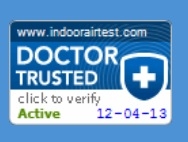News
Duct Cleaning....Time to Vent!
Washngton, DC -- October 27, 2008 -- Indoor Air Quality issues are rapidly becoming part of the general public’s conscientiousness through the mass media’s portrayal of proliferating toxic mold.
Many Floridians, along with the rest of the nation are now discovering that non-qualified commercial mold remediation firms and residential duct cleaning services can be just as hazardous. Numerous post-hurricane mold cleanup efforts have been ineffective. A recently published article stated that 40% of the certified duct cleaners don’t follow their certifying entity’s procedures and protocols. Many states are rushing to introduce legislation that qualifies and regulates the currently unregulated remediation industry.
The first step to consider before embarking on a mold remediation or duct cleaning project is to determine if the mold types and levels or duct condition are the source for a current or potential health problem. Keep in mind, the source of a mold problem may not be visibly apparent and just cleaning the ducts may not be the answer. Contact a reputable environmental consultant who can conduct an indoor environmental walkthrough that includes a pragmatic series of diagnostic tests to determine the environmental status of your home or office.
What Does Mold Remediation and Duct Cleaning Entail?
Mold Remediation includes a large variety of components (e.g. drywall, wood, carpet, building furnishings, etc.), which may also include duct cleaning. The type of mold, levels of contamination, and clearance levels will determine the protocols employed during the remediation project. It is important the remediation service provider environmentally cleans all the contaminated components so unclean sections will not re-contaminate the home or office again. Anti-microbial chemicals are sometimes applied during the cleaning process and in some cases incorporated into the encapsulating products. Ensure all chemicals used are EPA registered for the specific application. All MSDS sheets should be maintained on the project worksite. Some newer remediation efforts include cryogenic processes for mold treatment
Duct cleaning entails cleaning the various heating and cooling system components of forced air systems. These components include the supply and return air ducts and registers, grilles and diffusers, heat exchangers heating and cooling coils, condensate drain pans (drip pans), fan motor and fan housing, variable area volume (VAV) boxes, fresh air ductwork, and the air handling unit housing.
The service provider should take preventive steps to protect individuals from exposure to dislodged contaminants during the cleaning process. These steps may include the use of containment barriers; the utilization of negative air machines (NAM) employing High Efficiency Particulate Arresting (HEPA) filtration rated 99.97% efficiency for particulate size of .03 microns on the cleaning equipment, effective “tools of the trade” to facilitate proper removal, and the use of employees who are trained in OSHA safety practices. In an office type building, remediation should be performed at night, to again minimize the occupational disruption of the tenants and potential contaminants disturbed during remediation processes.
Signs for Mold Remediation:
The most efficient means of determining the presence of mold is through indoor environmental surveys. Oftentimes, building occupants exposed to mold contamination experience allergic symptoms, asthma attack, etc. Some non-ideopathic entities like rapid changes in air temperature and humidity levels, building pressurization, fluctuating lighting, odor causing evolutions can elicit similar symptoms and sometimes even can mask a mold-related problem.
Mold requires moisture for growth. Moisture intrusion due to poor construction design, materials, laborers, and technique is currently a major industry problem. There are currently no regulations for mold contaminant levels, but there have been multiple bills introduced at the various levels of government (federal and state) with regulation coming in the not too distant future. Opportunistic pathogenic molds are well documented as well as others that generate toxic chemicals (MVOC’s). Even if you have visible mold present, reputable professionals should do the qualification and quantification with all assay analyses performed by an accredited laboratory. Guidelines for acceptable levels of molds have been developed through trend analysis of the Computer Assisted Air Management Program Systems (CAAMPS) at the Environmental Diagnostics Laboratory of Pure Air Control Services. CAAMPS contains data from over 100,000 samples collected in over 500 million sq. ft. of commercial and residential sites.
Signs Ducts Should Be Cleaned:
There are several factors that help determine if the duct system should be cleaned. One major factor is visible mold growth inside hard surface ducts or on other components of your system. Be aware that although a substance may look like mold, it may not be. The use of an AIHA accredited environmental laboratory will accurately determine whether a sample is mold or simply debris that resembles it. If the air duct insulation is saturated with water, it should be removed and replaced and the cause of the growth corrected before the cleaning or removal occurs.
Other factors include rodent or insect infestation and a clogged HVAC system that actually releases contaminants into the building or home through the registers.
Risk Factors:
If proper mold remediation or duct cleaning procedures are not followed, these processes can cause more dust, debris, and molds to be released into the air. Inadequate negative air machine collection systems and poor containment can cause this problem. Also, there is the possibility the service provider can damage your ducts or heating and cooling system, which could result in increased heating and air conditioning operational costs, expensive repairs or replacements.
Listed below are questions that should be posed to the prospective remediation and duct-cleaning contractor:
* Are the New York City Department of Health Mold Remediation Guidelines level I through level V being utilized for mold cleanup?
* Is the company NADCA certified and in good standing?
* Are the NADCA ACR 2002 specifications utilized?
* Are the IICRC Standard for Professional Remediation S520 utilized?
* How long has the service provider been in business?
* Is their work mostly residential homes or commercial buildings?
* Does their respective state’s Department of Business and Professional Regulation (DBPR) require licensure?
* What are the qualifications of the firm?
* Do they guarantee their work?
* What is the guarantee?
* Does the firm work with the medical community? (Health implications of work)
* Are their chemicals registered with the EPA for specific ductwork applications? (Fiberglass vs. Sheet Metal)
* What quality control/quality assurances (QA/QC) protocols do they provide to assure that mold, fiberglass, dust, pollen, and dander have been effectively removed after the cleaning process?
* Are the technicians who will be performing the work environmentally trained?
* What are their backgrounds? Their experience? Have they been trained in the following OSHA programs:
* Respiratory Protection Program: 1910.134
* Hazard Communication Program: 1910.120
* Confined Space Program: 1910.146
* Lock Out - Tag Out Program: 1910.147
Detailed environmental HVAC and Mold project remediation specifications are essential in any indoor environmental remediation project and should be mandated to confirmed the qualifications of the individual as well as provide some assurity of the projects success.
An EPA Study
The information provided below are excerpts from EPA Pilot Field Study EPA-600/R-97-137 December 1997 prepared by National Risk Management Laboratory:
The EPA conducted a nine-home study in 1997 to investigate the impact of mechanical air duct cleaning (ADC) methods on indoor air quality (IAQ) and system performance. Only mechanical ADC methods were evaluated. Surface treatments, such as biocides or encapsulants, were not part of the study. Pre- and post-ADC measurements were used to evaluate impacts. These included deposited duct dust measurements, airborne particle and fiber concentrations, microbial bioaerosol and surface sampling, and system performance factors such as temperature, relative humidity, airflow rates, and static pressure.
Surface sampling in ducts indicated that mechanical ADC is effective in removing adhered dust and dirt (see fig. 1). Mechanical ADC did not significantly reduce bioaerosol or microbial density in the houses studied. None of the test houses were considered to be biocontaminated; therefore, a small change would not be surprising.
Fungal levels were generally higher than bacterial levels, and ADC had the most impact on the ducts with the highest levels of fungi and noticeably reduced the level of fungi in surface samples collected from ducts in most houses. Mechanical ADC methods alone did not substantially reduce bioaerosol and culturable surface microbial levels. Surface treatments such as biocides or encapsulants may be required if it is determined that substantial reductions are necessary.
Contact a professional if you think mold remediation and duct cleaning might be a good idea for your facility or residence, but keep in mind, the EPA does not establish duct cleaning and mold remediation standards, but there are other industry standards.
Unless you fully understand the pros and the cons of chemical biocides or sealants do not allow the use of them.
One Final Thought
In a building’s life cycle, dust, mold, moisture, etc. oftentimes accumulate over the next 5, 10, 15 years. Typically, 1-10 lbs. of debris will be removed from an older AHU/ACS system. This debris is a potential food source for mold and other microbial agents.
When your home or office was constructed and then subsequently occupied, the air handling system and associated air conveyance system was newly installed and clean. If not properly filtered during construction efforts, debris (e.g. drywall dust, sawdust, etc) can quickly contaminate HVAC Systems.
Initially, latent construction defects may not have been readily apparent and over time can provide an occasion for moisture intrusion, not only in the HVAC systems, but also in other areas of the building (exterior walls, window seals, roof leaks, plumbing leaks, etc.).
As with any professional, check references thoroughly to be sure other customers were satisfied and did not experience any problems with their heating and cooling system after cleaning and that mold levels were proven to be at a significantly lower level as proved through clearance testing.
Remember, one would only hire the best physician to identify and treat a physical ailment and should only use the best to identify and treat a problem home or building. Health is the primary concern of both.
About Pure Air Control Services:
Alan Wozniak founded Pure Air Control Services, Inc. in 1984 as a small mechanical contracting firm. Today, the work distributed from its offices in
Pure Air Control Services is a national provider of the following IAQ services: Building Sciences Evaluation; Building Health Check; Environmental Diagnostics Laboratory (EDLab) an AIHA accredited micro laboratory; Environmental Project Management; HVAC System Cleaning and Mold Remediation Services, among other indoor environmental services.
The company’s expanding client roster includes the General Services Administration (GSA); Federal Aviation Administration (FAA), Allstate Insurance; Carrier Air Conditioning; Naval Air Warfare Center, Orlando; and Naval Air Station - King's Bay, Georgia, and many other Fortune 500 companies, school boards, and city, state, and county governments, making Pure Air Control Services the reliable industry leader.
For more information contact Kevin McKee, Director of Remediation Sciences at 800.422.7873 ext. 403 or email kmckee@pureaircontrols.com

More News

IAQ Test Kits (DIY), PURE-Steam Coil Cleaning and PURE-Decon Room Treatment Showcased at the Annual FRACCA Conference
This annual event provides an opportunity for licensed contractors throughout the State of Florida to obtain all 14 state-required hours of continuing education over the course of the two-day event.
Released On: 3/8/2014
Views: 4361

Free Legionella Webinar: Detection & Identification Workshop
Although this type of bacteria was around before1976, more illness from Legionnaires' disease is being detected now. Due to consumer awareness, added research and technological advances in healthcare Legionnaires disease identification is becomi ...
Released On: 3/4/2014
Views: 4221

Why Some High-Performance Buildings Are Failing?
Performance of a building depends on its structured integrity, preventive maintenance, as well as periodical monitoring of the environmental conditions essential for its functionality.
Released On: 2/19/2014
Views: 4249

Legionnaire’s – What You Should Know About The Potential Deadly Bacteria
According to Building Operating Management magazine, expert Victor Yu, MD, Professor of Medicine, University of Pittsburgh; Chief, Infectious Disease Section, VA Medical Center, Pittsburgh, PA, disclosed that “Up to 70% of all buildings greater t ...
Released On: 2/18/2014
Views: 3808

Managing of Indoor Environments: Problems and Solutions - IEQ WEBINAR
Released On: 1/22/2014
Views: 3706

Save Energy and Improve Indoor Air Quality (IAQ) with PURE-Steam Deep Coil Cleaning
High efficiency coils are extremely susceptible to blockage from dust accumulation because once lodged deeply within the fins bacteria and mold may initiate growth, which not only compounds the blockage problems but also gives rise to excessive o ...
Released On: 1/8/2014
Views: 6481

January is National Radon Action Month
Exposure to radon is the second leading cause of lung cancer after smoking. Radon is an odorless, tasteless and invisible gas produced by the decay of naturally occurring uranium in soil and water.
Released On: 1/8/2014
Views: 4139

Why indoor air quality is important to all of us?
World Health Organization (WHO Guidelines for Indoor Air Quality, 2009) concluded that the most important effect is increased prevalence of respiratory symptoms, allergies and asthma, as well as perturbation of the immunological systems
Released On: 12/31/2013
Views: 4198

Pure Air Control Services Launches New Interactive Website
The website is a true indoor environmental resource for the private and public sector including consumers, educational facilities e.g. schools, universities, along with city, county state and federal governments, healthcare and the public sector.
Released On: 12/20/2013
Views: 3193

Pure Air Control Services Awarded Certification from Doctor Trusted
“We are very proud to have been given the opportunity to display that we are a Doctor Trusted recipient. We will continue as always to help provide our customers with a great products and services,” stated Dr. Rajiv Sahay, environmental analytica ...
Released On: 12/11/2013
Views: 4142

IndoorAirTest.com Receives Seal of Approval by Doctor Trusted
IndoorAirtest.com is very proud to have a Doctor Trusted seal of approval displayed on our website, giving our customers more confidence when shopping with us.
Released On: 12/4/2013
Views: 4566

PURE-Decon/Sanosil, Reduces Sick Days Caused by Infection
Released On: 10/2/2013
Views: 3492

Controlling Asthma & Allergy Triggers Through Source Identification
The assessment of allergens in a house dust sample is an essential step for allergen-avoidance and provides information essential for allergen-reducing measures, in addition to managing the indoor environment from a health and hygiene point of view
Released On: 9/18/2013
Views: 5587

Hospitals Get a “Clean Bill of Health” with Innovative IAQ/Energy Solutions
Healthcare-associated infections (HAIs) are infections that patients acquire during the course of receiving healthcare treatment for other conditions.
Released On: 7/31/2013
Views: 4615

How Safe is Formaldehyde in our Buildings and Homes?
Released On: 7/17/2013
Views: 4886

Commercial Energy Solutions Seminar July 26, 2013
Released On: 7/11/2013
Views: 4942

Health Risks Associated With Indoor Microbes
Some common and frequently reported microbes of the indoor environment include, but are not limited to, viruses, bacteria, mycoplasma, mold (fungi), yeast, protozoa, etc.
Released On: 6/26/2013
Views: 6097

Aspergillosis: A Cause for Indoor Concerns?
In indoor environments, this fungus can be transported from outside or may propagate on building materials such as cellulose rich sheet rocks, etc. and can generally be isolated from floors, carpets, mattress dust, Heating Ventilation Air Conditi ...
Released On: 6/19/2013
Views: 10796

Map
Pure Air Control, Services, Inc.
Get DirectionsPure Air Control, Services, Inc.
-
4911 Creekside Drive
Clearwater, Florida 33760
United States - 1 (800) 422-7873


